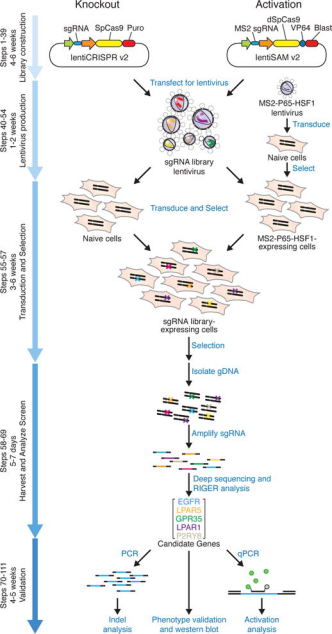 Lentiviral Packaging
Lentiviral Packaging
Service Details
| Service Type | Knockout Lentivirus / Overexpression Lentivirus / Interference Lentivirus / Library Virus |
|---|---|
| Delivery Standards |
1.Titer Report 2.Map 3.Lentivirus |
| Timeline/Pricing |
|
Service Advantages
Efficient Packaging System
Scientific Titer Measurement Method
Extremely High Safety
Experienced Team
Service Types
| Knockout Lentivirus | Delivers and integrates the CRISPR/Cas9 knockout system into the genome, enabling efficient knockout of target genes |
|---|---|
| Overexpression Lentivirus | Delivers and integrates exogenous gene fragments into the genome for efficient and stable expression of gene fragments |
| Interference Lentivirus | Delivers and integrates the shRNA interference system into the genome for long-term and stable knockdown of target genes |
| Library Virus | Delivers CRISPR/Cas library plasmids to cells and integrates them into the genome, effectively creating gene-edited mixed cell pools |
Delivery Standards
| Gene Knockout Virus, Overexpression Virus, Interference Virus | CRISPR/Cas9 Library Lentivirus |
|---|---|
|
Titer Report |
Titer Report |
| Plasmid Map | Plasmid Map |
|
Operation Manual |
Library Lentivirus( ≥1×106 TU/mL, delivery sizes:1×108 TU、5×108 TU、1×109 TU) |
| Lentivirus (Titer ≥ 1×106 TU/mL,1 mL) |
Service Workflow
Literature Review

Advantage and Characteristic

Optimazied Strategy

Optimazied Strategy

Optimazied Strategy

Optimazied Strategy
Genetic Reference Book
Constructing CBLB-overexpressing 293T cells using CBLB-OE lentivirus 
Specific changes in gut microbiota and metabolites are associated with acute myocardial infarction (AMI), and CBLB may play an important role in this process. However, the specific mechanisms of these interactions have not been thoroughly studied, leading to significant gaps in understanding. This study aims to investigate the effects of CBLB intervention on AMI mice through transcriptomic sequencing, 16S rDNA, and untargeted metabolomic analyses. The research team employed a multi-omics integrated strategy, <strong>including the transfection of CBLB lentiviral packaging vectors into 293T cells, followed by intervention in AMI mice, and conducting pathological staining, fecal 16S rDNA sequencing, and serum untargeted metabolomics analysis.</strong> The results showed that CBLB intervention significantly reduced inflammatory cell infiltration and collagen fiber formation in the infarct area of the mouse heart and led to key changes in microbiota, metabolites, and differentially expressed genes (DEGs). This suggests that CBLB may play a significant role in the regulation of AMI. The study confirms the potential of differentially expressed genes, metabolites, and microbiota in AMI regulation after CBLB intervention, providing a basis for future exploration of the therapeutic applications of CBLB.
Constructing SENP1-knockdown glioma stem cells (GSCs) using SENP1-shRNA lentivirus 
This study explores the impact of SENP1-mediated deSUMOylation on the malignant behavior of glioma stem cells (GSCs) under hypoxic conditions and its clinical significance. Under hypoxic conditions, HIF1α upregulation activates the Wnt/β-catenin signaling pathway in GSCs, supporting glioblastoma (GBM) growth. SENP1-mediated deSUMOylation stabilizes the expression of HIF1α and β-catenin, promoting tumor formation driven by GSCs. Downregulating SENP1 expression in GSCs using lentivirus-packaged SENP1 shRNA resulted in decreased proliferation and differentiation of GSCs, with a reduction in tumorigenesis.HIF1α-induced activation of Wnt/β-catenin is dependent on SENP1-mediated deSUMOylation, promoting GSC-driven GBM growth. The study suggests that targeting SENP1 may effectively enhance the therapeutic efficacy for GBM.


 Login
Login



